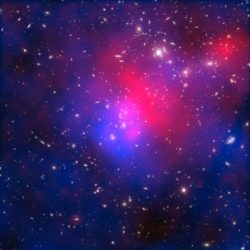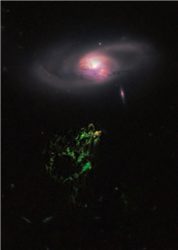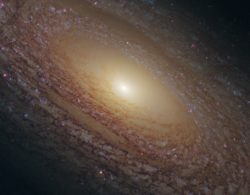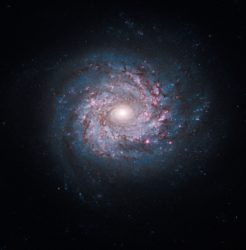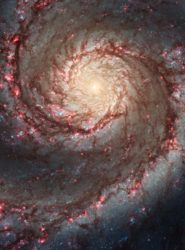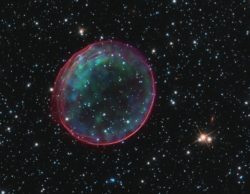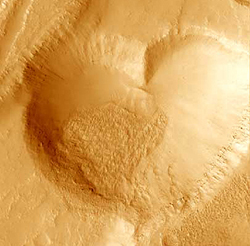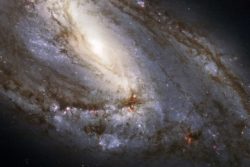Astronomy Picture of the Week – Pandora’s Cluster
This galaxy cluster commonly known as Pandora's Cluster is officially named Abell 2744. As observed by a team of scientists, the cluster has a complex and violent history. The giant galaxy cluster appears to be the result of a simultaneous pile-up of at least four separate, smaller galaxy clusters.
Astronomy Picture of the Week – Interacting Galaxy NGC 7469
This stunning pair of interacting galaxies are in the process of merging. The barred spiral Seyfert 1 galaxy NGC 7469 and its smaller companion IC 5283 are both located about 200 million light-years away from Earth in the constellation of Pegasus. This image was taken by NASA’s Hubble Space Telescope.
Astronomy Picture of the Week – NGC 6782
This spiral galaxy is called NGC 6782. When seen in visible light, it exhibits tightly wound spiral arms that give it a pinwheel shape similar to that of many other spirals. However, when viewed in ultraviolet light with NASA's Hubble Space Telescope, its shape is startlingly different.
Astronomy Picture of the Week – Space Oddity
This unusual ghostly green blob of gas appears to float near a normal-looking spiral galaxy in the image taken by NASA's Hubble Space Telescope. The bizarre object, dubbed Hanny's Voorwerp (Hanny's Object in Dutch), is the only visible part of a 300,000-light-year-long streamer of gas stretching around the IC 2497 galaxy.
Astronomy Picture of the Week – Spiral Galaxy NGC 2841
This view of the majestic disk of stars and dust lanes of the spiral galaxy NGC 2841 was taken by NASA’s Hubble Space Telescope in 2010. The galaxy lies 46 million light-years away in the constellation of Ursa Major. Credit: NASA, ESA, and the Hubble Heritage (STScI/AURA)-ESA/Hubble Collaboration Acknowledgments: M. Crockett and S. Kaviraj (Oxford University, UK), R. O’Connell (University of Virginia), B. Whitmore (STScI), and the WFC3 Scientific Oversight Committee
Astronomy Picture of the Week – Spiral Galaxy NGC 3982
This spiral galaxy, called NGC 3982, looks similar to our own galaxy but it is much smaller. NGC 3982 spans about 30,000 light-years which makes it roughly one-third of the size of the Milky Way galaxy. It is located about 68 million light-years away in the constellation Ursa Major. This image is composed of pictures taken by the Hubble Space Telescope’s Wide Field Planetary Camera 2 (WFPC2), the Advanced Camera for Surveys (ACS), and the Wide Field Camera 3 (WFC3) between March 2000 and August 2009. Image Credit: NASA, ESA, and the Hubble Heritage Team (STScI/AURA)
Astronomy Picture of the Week – Whirlpool Galaxy
This image of the spiral galaxy M51, dubbed the Whirlpool Galaxy, was taken by NASA’s Hubble Space Telescope. M51 is a typical spiral galaxy which includes graceful, curving arms, pink star-forming regions, and brilliant blue strands of star clusters. It is located at a distance of approximately 31 million light-years from the Milky Way Galaxy in the constellation Canes Venatici. It is one of the most famous galaxies in the sky. M51 can easily be observed by amateur astronomers, and may even be seen with binoculars. Image Credit: NASA, ESA, S. Beckwith (STScI), and the Hubble Heritage Team (STScI/AURA)
Astronomy Picture of the Week – Supernova Bubble Resembling Holiday Ornament
This image was made by combining data from two of NASA's Great Observatories: the Hubble Space Telescope and the Chandra X-ray Observatory. The supernova remnant, cataloged as SNR 0509-67.5, is the result of a type Ia supernova. It is located in the Large Magellanic Cloud (LMC), a small galaxy about 160,000 light-years from Earth.
Cosmic Hearts
I hope you all had a happy Valentine's Day! :) Here are some pictures of cosmic hearts: A heart-shaped crater on Mars captured by the Mars Orbiter Camera onboard the Mars Global Surveyor. A heart-shaped Nebula, called W5, located 6000 light years away in the constellation of Cassiopeia.
Astronomy Picture of the Week – Interacting Spiral Galaxies NGC 2207 and IC 2163
This near-collision has been caught in a photo by NASA's Hubble Space Telescope. Two spiral galaxies pass by each other like majestic ships in the night. They are located in the direction of the constellation Canis Major.
Antlia Constellation
Antlia is a constellation in the southern sky and therefore has been unknown to the ancient Greeks and Romans. Its name means “pump” and it specifically represents an air pump. It was created by the French astronomer Abbé Nicolas Louis de Lacaille, who created fourteen constellations for the southern sky to fill some of the faint regions. He originally named it Antlia pneumatica to commemorate the air pump invented by the French physicist Denis Papin. It was later adopted by the International Astronomical Union as one of the 88 modern constellations under the shortened name of Antlia. Main Stars and Deep Sky Objects The Antlia constellation has no bright stars.…
Astronomy Picture of the Week – Unusual Spiral Galaxy M66
This is a photo of an unusual spiral galaxy called M66, or NGC 3627, taken by the Hubble Telescope. It lies about 35 million light years from Earth and it spans 100,000 light years. At a first glance, this galaxy looks familiar. Why? Well, because it is similar to our own galaxy, the Milky Way. Both galaxies are spirals. However, what’s really unusual about this one is that it is asymmetric. Usually the force of gravity of a mega black hole (or group of mega black holes) attracts all the stars and interstellar gas in a symmetric pattern. If the mega black hole is not originally in the center of…

